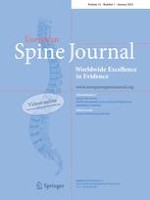19-11-2023 | Osteoporosis | Original Article
Assessing the utility of MRI-based vertebral bone quality (VBQ) for predicting lumbar pedicle screw loosening
Published in: European Spine Journal | Issue 1/2024
Login to get accessAbstract
Study Design
Retrospective cohort.
Objective
The purpose of this study is to assess the potential of utilizing the MRI-based vertebral bone quality (VBQ) score as a predictive tool for pedicle screw loosening (PSL) in patients who have undergone pedicle screw fixation and to identify risk factors associated with VBQ scores.
Methods
One hundred and sixteen patients who had undergone pedicle screw fixation between December 2019 and January 2021 and had more than a year of follow-up were divided into two groups of PSL and non-PSL. The radiological and clinical parameters investigated were age, gender, body mass index, the VBQ score, length of fusion and the DXA T-score.
Results
Of the 116 patients included in the study, 22 patients developed pedicle screw loosening after surgery (18.97%). VBQ score of PSL group was higher than the non-PSL group (3.61 ± 0.63 vs. 2. 86 ± 0.43, p < 0.001). According to logistic regression, PSL was independently linked with a higher VBQ score (OR = 3.555, 95% confidence interval [1.620–7.802], p < 0.005). The AUC of predicting screw loosening was 0.774 (p < 0.001) for VBQ score, and the best threshold was 3.055 (sensitivity, 81.8%; specificity, 71.3%). High VBQ score was associated with age (r (114) = 0.29, p = 0.002), while it was not negatively correlated with T-scores of each part.
Conclusion
VBQ score is an independent predictor of pedicle screw loosening, with higher scores indicating a greater risk. Our results showed that older patients and women had higher VBQ scores.





